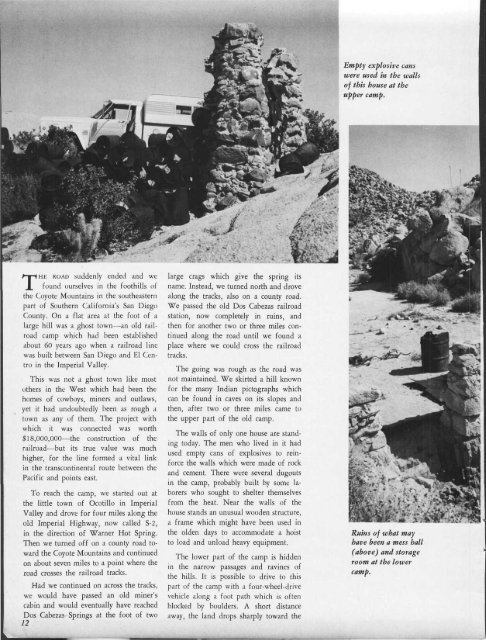Lost Mine Found! - Desert Magazine of the Southwest
Lost Mine Found! - Desert Magazine of the Southwest
Lost Mine Found! - Desert Magazine of the Southwest
You also want an ePaper? Increase the reach of your titles
YUMPU automatically turns print PDFs into web optimized ePapers that Google loves.
THK ROAD suddenly ended and we<br />
found ourselves in <strong>the</strong> foothills <strong>of</strong><br />
<strong>the</strong> Coyote Mountains in <strong>the</strong> sou<strong>the</strong>astern<br />
part <strong>of</strong> Sou<strong>the</strong>rn California's San Diego<br />
County. On a flat area at <strong>the</strong> foot <strong>of</strong> a<br />
large hill was a ghost town-—an old railroad<br />
camp which had been established<br />
about 60 years ago when a railroad line<br />
was built between San Diego and El Centro<br />
in <strong>the</strong> Imperial Valley.<br />
This was not a ghost town like most<br />
o<strong>the</strong>rs in <strong>the</strong> West which had been <strong>the</strong><br />
homes <strong>of</strong> cowboys, miners and outlaws,<br />
yet it had undoubtedly been as rough a<br />
town as any <strong>of</strong> <strong>the</strong>m. The project with<br />
which it was connected was worth<br />
$18,000,000—<strong>the</strong> construction <strong>of</strong> <strong>the</strong><br />
railroad—but its true value was much<br />
higher, for <strong>the</strong> line formed a vital link<br />
in <strong>the</strong> transcontinental route between <strong>the</strong><br />
Pacific and points east.<br />
To reach <strong>the</strong> camp, we started out at<br />
<strong>the</strong> little town <strong>of</strong> Ocotillo in Imperial<br />
Valley and drove for four miles along <strong>the</strong><br />
old Imperial Highway, now called S-2,<br />
in <strong>the</strong> direction <strong>of</strong> Warner Hot Spring.<br />
Then we turned <strong>of</strong>f on a county road toward<br />
<strong>the</strong> Coyote Mountains and continued<br />
on about seven miles to a point where <strong>the</strong><br />
road crosses <strong>the</strong> railroad tracks.<br />
Had we continued on across <strong>the</strong> tracks,<br />
we would have passed an old miner's<br />
cabin and would eventually have reached<br />
Dos Cabezas Springs at <strong>the</strong> foot <strong>of</strong> two<br />
12<br />
large crags which give <strong>the</strong> spring its<br />
name. Instead, we turned north and drove<br />
along <strong>the</strong> tracks, also on a county road.<br />
We passed <strong>the</strong> old Dos Cabezas railroad<br />
station, now completely in ruins, and<br />
<strong>the</strong>n for ano<strong>the</strong>r two or three miles continued<br />
along <strong>the</strong> road until we found a<br />
place where we could cross <strong>the</strong> railroad<br />
tracks.<br />
The going was rough as <strong>the</strong> road was<br />
not maintained. We skirted a hill known<br />
for <strong>the</strong> many Indian pictographs which<br />
can be found in caves on its slopes and<br />
<strong>the</strong>n, after two or three miles came to<br />
<strong>the</strong> upper part <strong>of</strong> <strong>the</strong> old camp.<br />
The walls <strong>of</strong> only one house are standing<br />
today. The men who lived in it had<br />
used empty cans <strong>of</strong> explosives to reinforce<br />
<strong>the</strong> walls which were made <strong>of</strong> rock<br />
and cement. There were several dugouts<br />
in <strong>the</strong> camp, probably built by some laborers<br />
who sought to shelter <strong>the</strong>mselves<br />
from <strong>the</strong> heat. Near <strong>the</strong> walls <strong>of</strong> <strong>the</strong><br />
house stands an unusual wooden structure,<br />
a frame which might have been used in<br />
<strong>the</strong> olden days to accommodate a hoist<br />
to load and unload heavy equipment.<br />
The lower part <strong>of</strong> <strong>the</strong> camp is hidden<br />
in <strong>the</strong> narrow passages and ravines <strong>of</strong><br />
<strong>the</strong> hills. It is possible to drive to this<br />
part <strong>of</strong> <strong>the</strong> camp with a four-wheel-drive<br />
vehicle along a foot path which is <strong>of</strong>ten<br />
blocked by boulders. A short distance<br />
away, <strong>the</strong> land drops sharply toward <strong>the</strong><br />
Empty explosive cans<br />
were used in <strong>the</strong> walls<br />
<strong>of</strong> this house at <strong>the</strong><br />
upper camp.<br />
9, •&ft<br />
mi<br />
Ruins <strong>of</strong> what may<br />
have been a mess hall<br />
(above) and storage<br />
room at <strong>the</strong> lower<br />
camp.

















